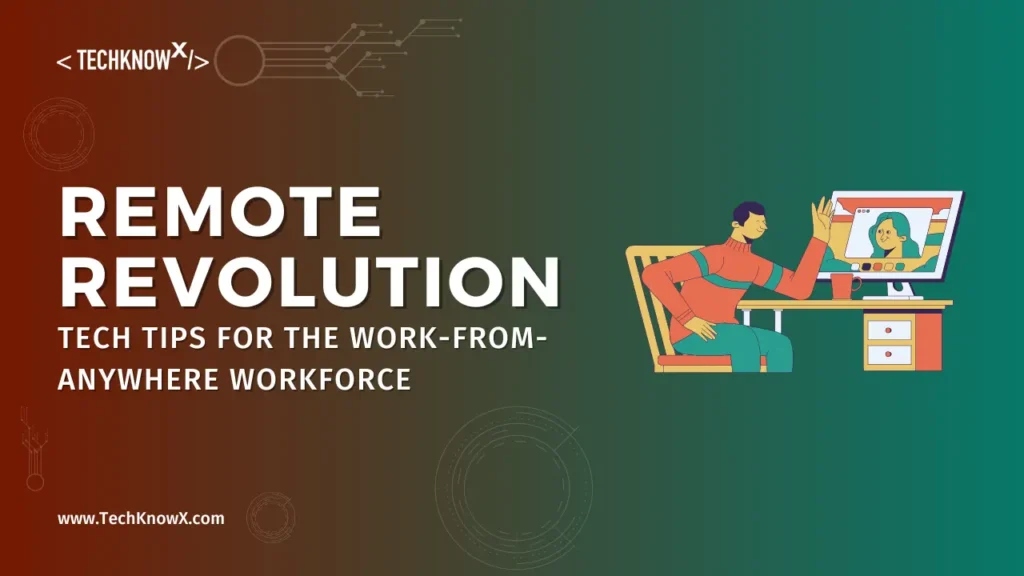TechKnowX in this article trying to figure out The Rise of the Remote Revolution: Tech Tips for the Work-From-Anywhere Workforce which is getting popular day by day.

The traditional office environment is experiencing a profound transformation. The COVID-19 pandemic acted as a catalyst, compelling organizations to adopt remote work on an unprecedented scale. What began as a necessity has evolved into a preference for many employees and companies. Welcome to the remote revolution, where location independence is no longer a perk but a defining characteristic of the contemporary workplace.
This newfound flexibility offers both opportunities and challenges. For employees, the ability to work from anywhere enhances work-life balance, reduces commuting stress, and broadens career prospects. For companies, remote work enlarges the talent pool, cuts overhead costs, and promotes a more diverse and inclusive workforce.
However, remote work necessitates a significant shift in mindset and approach. Without the physical separation of a traditional office, maintaining productivity and fostering a sense of connection with colleagues can be daunting.
Fear not, dedicated remote worker! This article provides essential tech tips and tools to help you thrive in the work-from-anywhere revolution.
Building Your Remote Tech Stack: Essential Tools for Success
A successful remote work setup hinges on a robust tech stack. This refers to the suite of software applications and online tools you’ll use to collaborate, communicate, and manage your work efficiently. Here’s a breakdown of some essential tools:
Project Management & Collaboration
- Asana and Trello: Offer user-friendly interfaces for creating tasks, assigning deadlines, and tracking project progress in real-time.
- Monday.com: Provides a customizable workspace for managing complex projects with features like team discussions and kanban boards.
Communication & Video Conferencing

- Zoom and Microsoft Teams: Popular choices for video conferencing, online meetings, and instant messaging.
- Slack: Facilitates real-time communication within teams with channels, direct messaging, and file sharing capabilities.
Cloud Storage & File Sharing
- Google Drive and Dropbox: Ensure your files are accessible from any device, fostering seamless collaboration and version control.
Time Management & Productivity
- Toggl Track and RescueTime: Help track your time spent on tasks, providing valuable insights into your work habits and identifying areas for improvement.
- Focus Keeper: Utilizes the Pomodoro Technique to break down work into focused sprints interspersed with short breaks, promoting sustained productivity.
Security & Privacy
- Virtual Private Network (VPN): Encrypts your internet traffic, safeguarding sensitive data when working on public Wi-Fi networks.
- Password Management Tools: LastPass and 1Password help you create and store strong, unique passwords for all your online accounts.
Additional Tips for Optimizing Your Tech Stack
- Integrations: Look for tools that integrate seamlessly with each other, fostering a streamlined workflow.
- Mobile Accessibility: Ensure your chosen tools offer mobile apps for on-the-go access and flexibility.
- Free vs. Paid Options: Many tools offer free basic plans with paid options for advanced features. Evaluate your needs and budget before investing.
Creating Your Remote Workspace: Optimizing Your Environment for Focus
Your workspace plays a crucial role in your remote work experience. Here are some tips to create a dedicated and distraction-free environment:
- Dedicated Work Area: Designate a specific area in your home as your workspace. This helps separate your work life from your personal life and promotes a focused mindset.
- Ergonomics: Invest in an ergonomic chair and desk setup to maintain good posture and prevent discomfort during long work hours.
- Minimize Distractions: Find a quiet location away from household noise and activity. Utilize tools like noise-canceling headphones and consider white noise generators to mask background sounds.
- Personalize Your Space: Add elements that inspire and motivate you. A comfortable chair, good lighting, and pictures of loved ones can all contribute to a positive work environment.
- Pro Tip: Experiment and find what works best for you. Some individuals thrive in a minimalist space, while others benefit from visual inspiration around them.
Staying Connected and Collaborative: Building Relationships in a Remote World
While remote work offers flexibility, it can also lead to feelings of isolation and a disconnect from colleagues. Here are some strategies to foster strong team relationships and collaboration:
- Schedule Regular Video Meetings: Go beyond just business meetings. Schedule informal coffee chats or virtual team lunches to foster social connections.
- Utilize Communication Channels: Actively use collaborative tools like Slack to stay connected throughout the day, share updates, and ask for help.
By leveraging the right technology and creating an optimal workspace, you can thrive in the remote revolution. Embrace these tools and tips to maintain productivity, foster collaboration, and achieve a fulfilling work-from-anywhere experience.
FAQs
Remote work enhances work-life balance, reduces commuting stress, and broadens career opportunities by allowing employees to work from anywhere.
Companies can access a larger talent pool, reduce overhead costs, and promote a more diverse and inclusive workforce by adopting remote work practices.
A robust remote work tech stack should include project management tools (e.g., Asana, Trello), communication platforms (e.g., Zoom, Slack), cloud storage solutions (e.g., Google Drive, Dropbox), time management apps (e.g., Toggl Track, Focus Keeper), and security tools (e.g., VPNs, password managers).
Designate a specific area for work, invest in ergonomic furniture, minimize distractions, and personalize your space with inspiring elements to create an effective remote workspace.
Schedule regular video meetings, utilize collaborative tools like Slack, and organize informal virtual gatherings to maintain team collaboration and foster social connections.



